10.08.2023
To be found in translation; doing things to/with dance with/to words
Χορος
Γλώσσα πρωτότυπου κειμένου: Αγγλικά
It is often mentioned that we are lost in translation whenever we try to give an account of dance using words. A kind of persistent torment that accompanies the shift from a sensorially rich experience to something that is believed exclusively cerebral (and maybe too rational). Could we for now debunk this logic and accept the fact that dance has always, somehow, been found in translation? An invitation, thus, to consider dance a rare medium that not only reconciles language and embodied experience, but also becomes an exemplary form of translation? Is it then that because of dance we often find ourselves oscillating between language and body, inventing a langage¹ while at the same time reaching towards the unspeakable?
Of course, one might say that speech is so widespread in dance performances nowadays that we barely see dancers just dancing. What I would like to imply here is something more than just speaking while/and dancing; rather, to suggest an art of translation that could establish a deeper relation between the two mediums, “an art of the flight [‘fugue’] from one to another, in which neither the first nor the second are effaced.”² More than dance and more than speaking words; closer to what Shoshana Felman³ suggests by “speaking an act”―and not simply a speech act―or even an attempt to move (with) words. For this reason, I am bringing into discussion two different performances that challenge the way speech and language are introduced into dance; the one is “Audible Dances” by Georgia Paizi & COCHLEA Res and the other is “Phrases” by Venetsiana Kalampaliki.
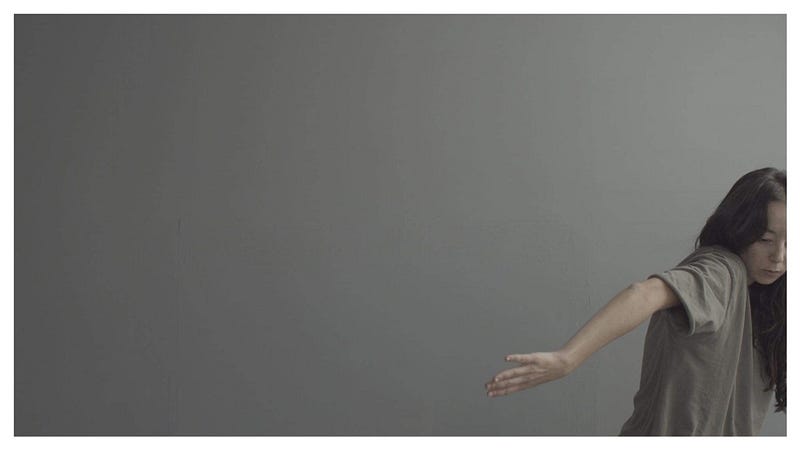
“Audible Dances” is a series of audio-dance soli and duets⁴, tracks we could conveniently listen to while at home, wearing headphones. Listening, in this case, is not just limited to acoustics, it could also imply various sensory occurrences not registered by vision and a sort of amplified awareness that requires from us to notice stimuli which challenge both our hearing patterns and attention span. These were ²dances developed during the covid pandemic (2020–1) and as we could more or less hesitantly remember, during a period that physical intimacy and gatherings in closed spaces were avoided if not prohibited. With that being said, “Audible Dances” seem to evolve around the following question: How could dance be preserved if broadcasted vocally? Could dance resonate as a voice in our heads and, if so, what would its traces be?
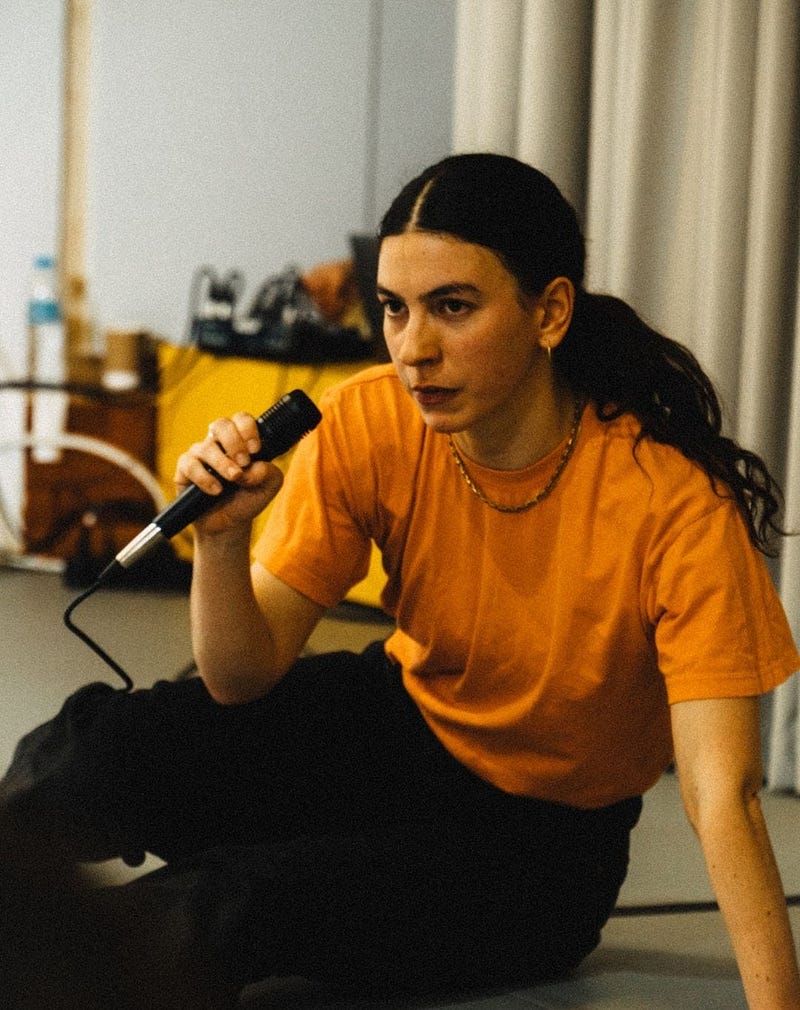
With the absence of any visual trace of the performer, one is invited to listen to motion, to focus on the miniscule almost imperceptible sounds of the fabrics, the brushing of the limps against the surface of the floor, to experience the body as an affective milieu beyond the visual logic. Also, to examine, in relation to what is being described, the less signifying elements of spoken language, such as the tone of the voice, the rhythm, the breath in-between pauses, the very performance of its (embodied) communicability. In this case, when the performer says “I jump” (run, roll, sit, lie, bend, touch and so forth) none of the actions are performed before our eyes; instead, language does what we assume the body performs, an act is spoken producing, consequently, an act of listening.
Since the truth or falsity of what is being said/done cannot be proven, one might think that their performative aspect is annulled. Language here is on an impossible mission; to register the performed movements but just as in seeing, we soon become aware that our perception of the oral account remains only futile and fragmentary. What stays with us, however, is the voice of the performer, the voice’s resonance in our heads, the way we are placed in language and, thus, somehow placed in the world with/of others. This sort of synesthetic-kinesthetic attributes seem to address the difficult question: how do I move you when I move (with my) words?
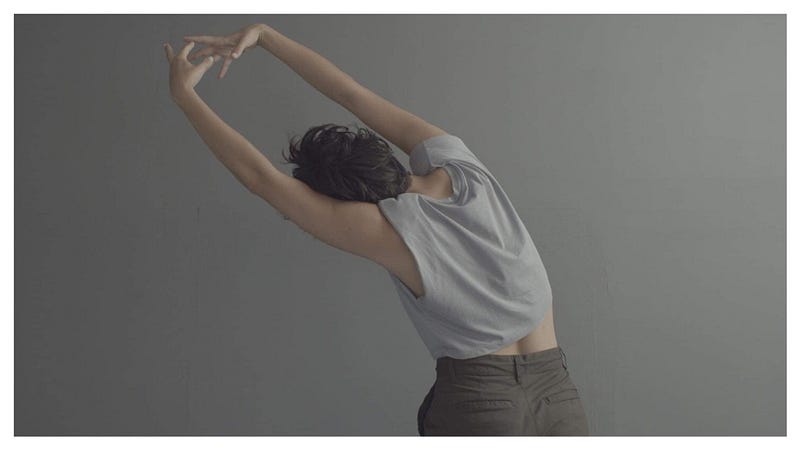
As Jean Luc Nancy has argued, the paradox when listening to someone is “to be at the same time outside and inside, to be open from without and from within, hence from one to the other and from one in the other.”⁵ This coterminous sense of neither here nor there, neither inside nor outside, neither material nor immaterial brings into discussion issues that go beyond self-presence and retackles how the body is often captured, scrutinized and framed upon its appearance in dance. Listening implies communicational contact even when that contact remains elusive; indeed, it is a useful reminder that attention and distraction can exist simultaneously, making hearing a truly threshold experience. As such, not only does it reveal the body’s potential for mediation, but also invests into the further exploration of communication formats, be it somatic and (para)linguistic.
If we could do things to/with dance with/to words, then this form of translatability between spoken language and movement becomes “a beautiful relinquishing,” a reaching towards the unpresentable or the unknowable, a dance so transparent as to see through it, a mouthful with-ness as to perceive something that often eludes our gaze; the Other, the many others that could give shape to an aural (and oral) encounter. However, aural here does not refer so much to hearing but “to a very broad and open state of sensuous/sensory perception” as Gabriele Brandstetter explains. Thus, listening is not primarily of hearing, but constitutes “forms of awareness which embrace both conscious and unconscious ‘subliminal’ perceptions.”⁶ This rare point of entry, considering movement from an aural perspective, might also incite us to consider the moving body differently; less objectified, less materialized, less deprived of its subjectivity.
The economy of the felt body is also addressed in the piece “Phrases” by Venetsiana Kalampaliki.⁷ Again language is a way not only to communicate with the audience, but also to explore other performative, inclusive aspects intertwining speech and movement. As an introduction, the performer gives an account of the things she will be doing, yet she specifies “what is said and what is done will not always agree.” Isn’t this, anyway, the fundamental problem of speech, the act of failing to keep one’s word, the “capacity for misfire” as Felman says, which is the capacity to miss its goal and to fail to be achieved?⁸ Therefore, could one say that things-being-said are not simply, exactly, merely, only, purely things-being-done? And how this slippage could be making any difference for the theatrical gesture and what does it communicate?
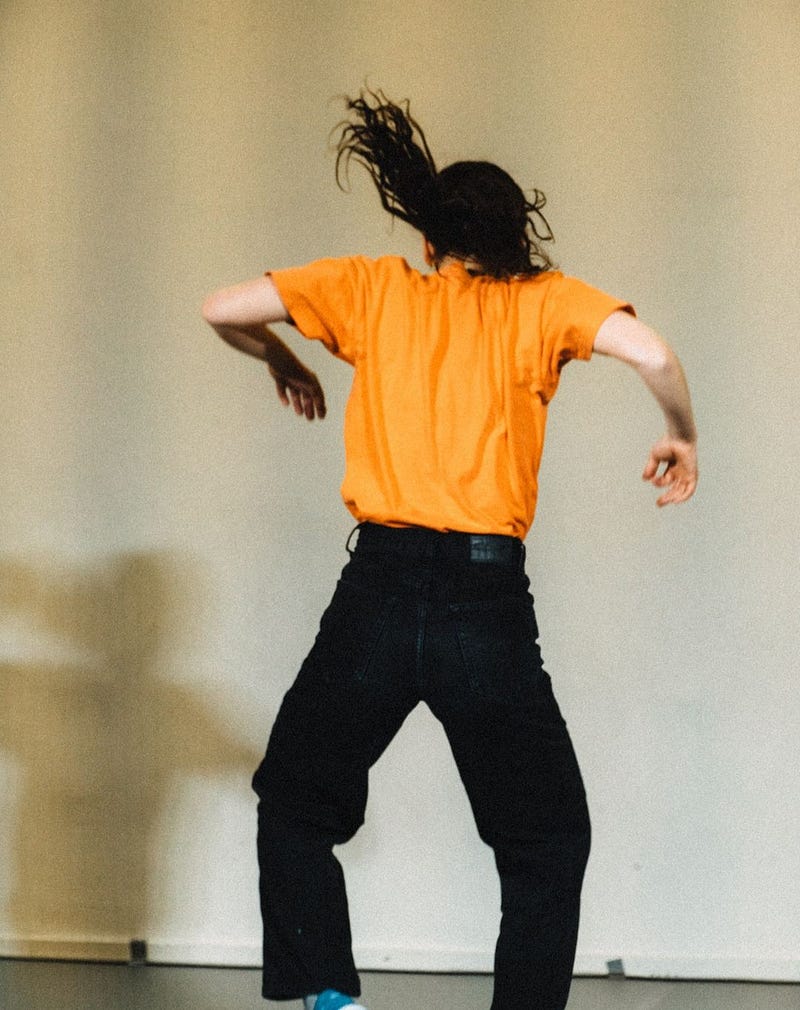
In the open rehearsal of the performance some of the stage elements that were supposed to be there are missing. But still Kalampaliki does “as if” they were there, she sticks to perform what is being communicated, all the same. For those who don’t have a prior staged experience of “Phrases,” this paradox seems to work. Actually, a posteriori, I tend to believe that the paradox is at the heart of this work, at times a linguistic paradox when words become the vessel for a yet unestablished intimacy, at times a paradoxical mise-en-abyme, when an action is spoken, then read as text on the (missing) screen and then re-performed. “There is a line between us” the performer says, but maybe this line is made of words, it speaks of how language inserts itself in reality, constructs it and mediates it. Kalampaliki keeps re-introducing phrases she uttered a moment ago as quotations of herself, rephrasing herself, constantly re-interpreting how her body is perceived, looked at, heard, put into words and into actions.
I think this fragmentary account of what constitutes being-in-language attempts to make evident how bodies are marked by words while their performed actions expand the discursive field of language; becoming-body cannot be foretold, only experienced. As relations are formed on various affective milieus, be it auditory, visual or haptic, they become embodied, which is to say that becoming-body could somehow be equivalent to being-relational. To paraphrase Kalampaliki, “Language is a door. You may use it accordingly.” Yet, sometimes, exiting/entering becomes a matter of perspective; “I am sitting on a chair typing,” this could be my phrase now, this could be me in front of the screen, fingers synchronized on the keyboard, touching letters to form words, to become something else, as I am trying to give an account of the experienced event.
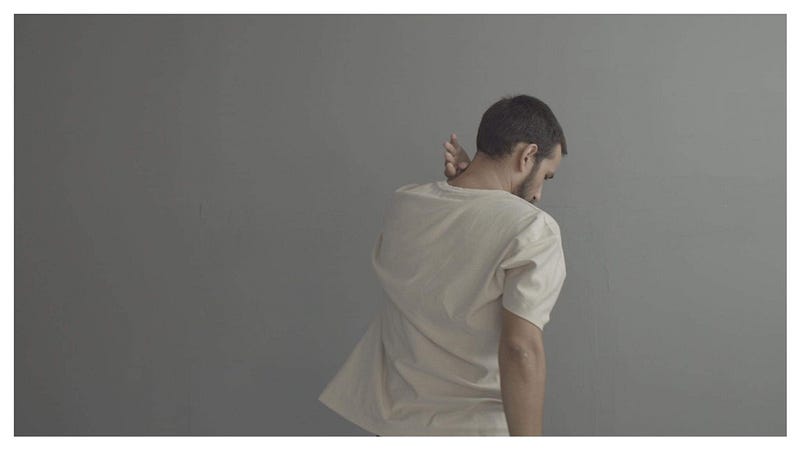
I am often reminded in performances like “Phrases” that we ought to return to a poetic language so as to learn to facilitate a different perception of bodies and movement. It is what Glissant names as “writing towards the difficult,” inventing a language to name things, sensations, movements, bodies, that pervert the norm of any formal language from the inside, “generating a langage that weaves together the poetics, maybe the conflicting poetics,”⁹ of bodies and speech, of speaking bodies, of even unspoken bodies. Maybe bodies could show us a poetic way to go behind appearances and introduce us to an infinite variation of sensibilities or even help us claim what Paul Valéry once wrote; the ear “keeps watch, so to speak, at the frontier beyond which the eye does not see.” Could you see/hear/feel me dancing?
Georgia Paizi is a dance-artist based in Athens/Greece, where she makes, teaches and writes on dance and the moving body. Georgia’s current dance practice explores the concepts of language, lexicon and vocabulary as common ground between movement and spoken word practices, tracing the dance in the absence of dance, as well as the contemporary rituals of social dancing in the era of social distancing and the shrinking of public space. Georgia works as a choreographer with the collective COCHLEA res, through which she also organises the programme SynAski/14. COCHLEA res has been receiving funding from the Greek Ministry of Culture and Sports since 2020. Georgia teaches movement, improvisation strategies and the Alexander technique since 2014 in Greece, London and Berlin. She studied dance in London, Amsterdam and New York (MA Creative Practice — Dance Professional delivered by the organisation Independent Dance at Trinity Laban in London; Alexander technique 3-year training at London Centre for Alexander Technique and Teacher Training), and social sciences and humanities in Greece (MA in Design — Space — Cultural Studies jointly offered by the School of Architecture and the School of Applied Mathematics and Physical Sciences of the National and Technical University of Athens; BA in Theatre Studies, University of Patras). She has been awarded the Stavros Niarchos Foundation Artist Fellowship by ARTWORKS (2021).
Venetsiana Kalampaliki (b. 1991, she/her) works in the field of performing arts as a dancer and choreographer. She explores movement through media such as text and video and develops her artistic practice through interdisciplinary collaborations and through her participation in workshops and festivals of contemporary dance, digital and visual arts, performance and disability arts. She is a graduate of the School of Economics and Political Sciences, National and Kapodistrian University of Athens (2018) and of the National School of Dance in Athens (2016) and is currently studying for a Master in Fine Arts at the Athens School of Fine Arts (2021–22). Her project Recall (2020–21), an Onassis Stegi production developed in the framework of the EU program Europe Beyond Access, was presented at the New Choreographers Festival 7 organized by Onassis Stegi; the Holland Dance Festival in the Hague; the 27th Kalamata International Dance Festival; and at the Oriente Occidente Dance Festival, Skånes Dansteater in Denmark. In 2021, she created the digital group project Besuch at the New Choreographers Festival 8 organized by Onassis Stegi. In 2021–22, she was a resident choreographer at the program K3 — Zentrum für Choreographie | Tanzplan Hamburg, where she conducted research on how she can integrate accessibility services within her artistic practice and presented the piece Phrases at Kampnagel theater. She has been awarded the Stavros Niarchos Foundation Artist Fellowship by ARTWORKS (2022).
Anastasio Koukoutas is working in the field of dance theory, dramaturgy and writing. He studied (BA) Communication and Marketing at the Athens University of Economics, (MA) Performing Arts Administration at Accademia Teatro alla Scala (in collaboration with Bocconi University), Ethnomusicology at the National and Kapodistrian University of Athens (within the e-learning course Greek Music Culture and Education). He has worked, in the publishing field, as a contributor and editor, for art institutions and organizations, such as: Athens & Epidaurus Festival, Stegi Onassis, Dimitria Thessaloniki Festival, Megaron — The Athens Concert Hall et.al. He has worked as a dramaturg in theatre and dance performances (Athens Festival, Stegi Onassis, Experimental Stage of National Theatre in Greece, Arc for Dance Festival, Porta Theatre — Athens et.al.). He writes frequently about dance for the websites springbackmagazine.com, artivist.gr, und-athens.com, and teaches Dance History at the dance college ΑΚΤΙΝΑ. Last but not least, he has worked as a performer for Denis Savary (Lagune –National Museum of Contemporary Art, Athens — 2016), Virgilio Sieni (Biennale Danza / La Biennale di Venezia — 2016), Pierre Bal Blanc (documenta14–2017), Dora Garcia (Megaron, The Athens Concert Hall — 2018) et. al.
¹ Éduard Glissant is using the term “langage” to denote the speaker’s subjective attitude to the “langue” that s/he uses. In the same vein, I am proposing here dance not as a universal language, as it is often quoted, but as “langage” denoting the subjective use of the moving body.
² Éduard Glissant, Introduction to a Poetics of Diversity, Liverpool University Press, p.27
³ Shoshana Felman, The Scandal of the Speaking Body, Stanford University Press, p.5
⁴ Also, a video version of “Audible dances” in collaboration with director Iasonas Arvanitakis was presented in AVDP 2022 but I am focusing only on the audio version, available also here: https://soundcloud.com/georgiapaizi
⁵ As quoted in Lisa Blackman, Immaterial Bodies, SAGE, p.139
⁶ Touching and Being Touched, Kinesthesia and Empathy in Dance and Movement, eds Gabriele Brandstetter, Gerko Egert and Sabine Zubarik, DE GRUYTER, p. 165
⁷ I saw an open rehearsal of the piece, presented within the ARTWORKS Dance Fellows platform at M54 Collective Space (Athens). “Phrases” is a production by Venetsiana Kalampaliki and K3 — Zentrum für Choreographie | Tanzplan Hamburg.
⁸ Felman, ibid.
⁹ Glissant, ibid.



